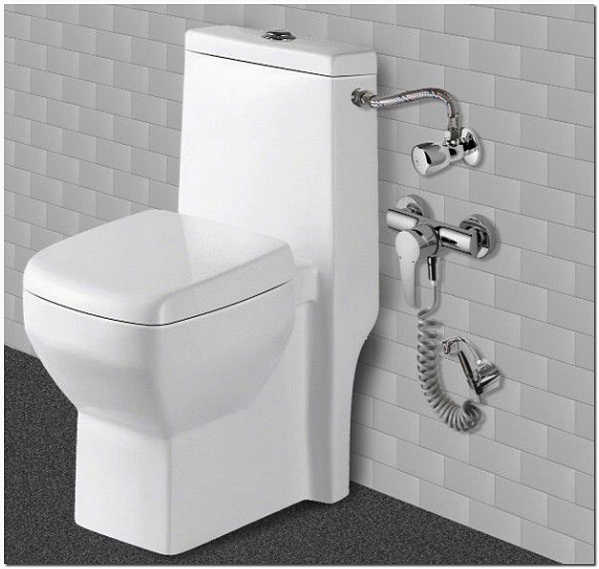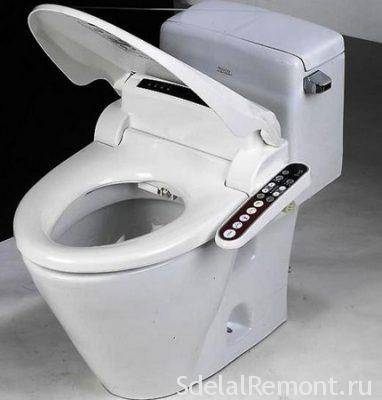Connecting a hygienic showerInstalling a hygienic shower in a toilet
Installing a hygienic shower is a good alternative to a bidet. If you do not have the opportunity to put a bidet in the bathroom, but there is a need for this, then the way out of the situation will be the installation of a hygienic shower. The device is compact, but no less convenient. A hygienic shower differs from a conventional shower in the size of the watering can and in that it is made of a special chrome-plated material that does not allow dirt and dust to accumulate.
Hygienic shower is divided into the following categories:
1) Installation of a hygienic shower in the seat - toilet lid;
2) Installing a hygienic shower built into the toilet;
3) Hygienic shower installed next to the toilet on the sink;
4) Installation of a hygienic shower with a mixer (external or built into the wall);
The most common among our customers is a shower connected to a sink or shower faucet (in the absence of a sink). This is due to a fairly inexpensive price and a variety of models on the market for sanitary equipment. The composition of the hygienic shower includes: a watering can, a hose and a mixer. If you do not have the opportunity to put a sink in the toilet room, then you should use a faucet with a hygienic shower without a spout.
When you open the shower, water will immediately flow into the hose and watering can. On the watering can itself there is a special valve, when pressed, water begins to flow, and when it is released, the water stops flowing.
It is very important to remember that after taking hygiene procedures, the tap must be closed, otherwise it will end in a flood. If there is a sink, then the mixer will be needed with a spout with an outlet for connecting a shower
By opening the faucet, water will flow into the sink, and by pressing the valve, water will flow from the watering can. Installing a hygienic shower significantly saves space, which is very important when the toilet rooms are small.
A hygienic shower can be installed in the toilet room at any time without resorting to repairing the bathroom. A hygienic shower is connected to existing communications. Water is connected both from the sink and from the risers of hot and cold water, as well as plumbing passing through the toilet room. Experienced specialists - plumbers are advised to purchase a wall-mounted hygienic shower with an open installation method.
The advantages of a hygienic shower are that there is no need to move from place to place (as is the case with a bidet) and there is a significant space saving. Some people think that installing a hygienic shower is not necessary, but if several people live in an apartment, then a hygienic shower is a good alternative to a bathroom.
In any case, an experienced plumber will always tell you which of the hygienic shower options is right for your toilet room.
Selection Guide
Almost all types of hygienic shower are presented in plumbing and sanitary ware stores. The matter remains small: choose the type of shower, material of manufacture, design and quality. When buying a device, consider the following features:
Device design. Some models do not allow you to connect to two pipes at the same time, then only cold water is obtained at the outlet.
Mounting method. Sometimes, when wall-mounted, residual drops are found on the shower head that drip onto the floor
Product material
Prefer brass with a chrome finish, this option is the most durable in use.
Study the demand in the market, always choose value for money, and pay attention to warranty and service.
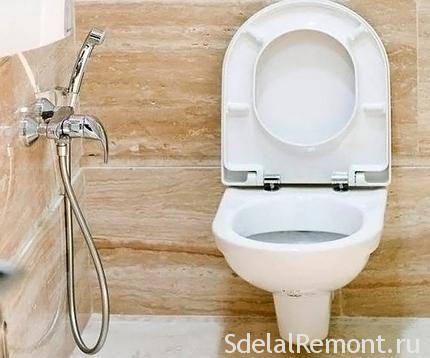
What is a hygienic shower
The purpose of a hygienic shower is clear to everyone. It is necessary for washing intimate places in order to maintain personal hygiene. Since it will be used often, the device of this equipment must be approached with all seriousness.
Hygienic shower consists of the following elements:
- mixer without spout (single-lever or double-lever);
- watering cans;
- flexible hose;
- watering can holder.
In some sources, a bidet or toilet with a bidet function is considered as a hygienic shower. However, this does not seem correct. A bidet and a toilet with a bidet function are independent sanitary equipment that allows you to perform personal hygiene procedures.
A shower, whether hygienic or otherwise, requires a watering can, a flexible hose and a mixer. Only such a complete set of equipment can be called a "shower". Therefore, it is precisely this that is considered further.
But there are also faucets that are installed directly into the toilet lid. These designs always provide one of two possible control methods: manual or electronic. Models of the second type are more modern and more expensive. The toilet sanitary shower with faucet can be purchased separately and installed by yourself.
Multifunctional hanging toilets
Floor-standing toilets, which most consumers are accustomed to, are gradually being replaced by hanging models. An unusual design and obvious advantages in cleaning the bathroom are appreciated by an increasing number of buyers. Manufacturers offer owners of apartments with small bathrooms to install hanging toilets complete with a hygienic shower connected to an installation that provides water supply to the mixer.
In the false wall covering the metal frame of the installation, a place is provided for installing a watering can holder and a mixer, to which hot and cold water is supplied. All communications are hidden behind a false wall, thereby increasing the attractiveness of the interior of the bathroom. The installation of a hanging toilet is carried out on its own according to the instructions supplied by the manufacturer of the sanitary ware, or they invite a plumbing specialist.
As you can see, there is nothing complicated in installing a hygienic shower for the toilet. The course of installation work depends on the features of the purchased equipment model. When installing this device, you need the same tools as for installing other types of plumbing.
Product varieties
Today's market for hygienic shower models is represented by several options. Each of them has its own characteristics and features in the application. The water connection can be hidden in the wall, as well as located in a conspicuous place. In this case, built-in models imply some kind of repair if the device breaks down.
The design of the device is simple and in order to use it, you just need to press the button located on the watering can, before opening the mixer valve.
If a thermostat is provided on the watering can, then the temperature is set only once, and subsequently it remains the same as it was set. In this case, the shower system will remember the desired temperature and will output it every time you turn on the watering can.
In order not to bother with repairs, in the process of connecting water to the mixer, simply lay the necessary pipe by connecting it to the nearest plumbing fixture.
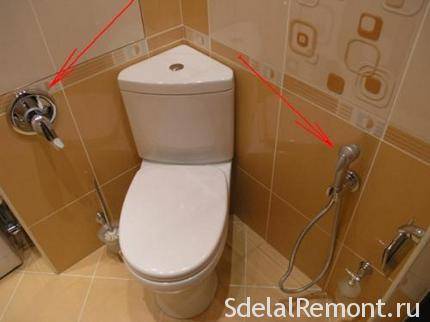
Hygienic shower with sink. If the bathroom involves the location of the sink next to the toilet, then you must choose a faucet equipped with a third outlet for water. Then, if necessary, water will be supplied to the shower head.Such a device works like this: when the tap is opened, water is supplied to the nose of the mixer, and is held there until the control button is pressed. As soon as the button is pressed, the water flows to the hygienic shower head. Such a shower model will perfectly fit into a small-sized or combined bathroom. A variety of product options, allows you to fix the shower directly on the sink. And if the bathroom is very small, you should try to choose a sink with a corner placement, which is installed above the toilet bowl. Such a move will save additional space in the room.

Installation of this type of hygienic shower is quite easy and is equivalent to installing a conventional sink. The main design feature: mixer with a third outlet. After using the tap, do not forget that it is necessary to turn off the mixer, otherwise the water from it will flow into the sink.
Toilet-bidet. This is a multifunctional device that looks like a standard toilet, but is equipped with a special nozzle for water supply. The nozzle must be retractable and have a power button. Usually it is placed on the rim of the toilet bowl.
The water supply to the mixer in such devices is connected to the installation from below through a separate hose.
Such a universal device is good because it can be used both in conventional toilet bowls and in hanging ones, which significantly saves space in the bathroom. The design of the installation itself is a metal frame on which the bowl is attached. By pressing the button on the toilet, the nozzle extends and supplies water at the desired temperature. At the end of use, the nozzle hides in its place. The pipe connection to such a toilet bowl - bidet is carried out behind a false wall. The model is compact, but has a high cost, which depends on the set of additional features and the manufacturer.
Bidet cover. Another option for a hygienic shower. Such a cover has a certain set of functions, which may include heating water to the desired temperature. The toilet lid is portable. It is equipped with control buttons that allow you to select one or another function. The lid itself is connected to the sink or to the tee, which is responsible for supplying water to the drain tank.
Bidet covers are mechanical and electronic. The latter option is mains powered, more expensive, and may have additional features. However, in the absence of electricity, the possibility of using a bidet cover is reduced to zero, due to the fact that the water will be heated from the power supply.
A variety of models allows you to choose exactly the option that is most suitable for a bathroom with certain conditions.
Installation options for a hygienic shower in the toilet
You need to think about how the hygienic shower in the toilet will be arranged at the stage of piping (if it is a new building) and choosing a place to install it (if it is an operated housing). There are three options for installing a hygienic shower:
- Open.
- Closed.
- Connection to the sink.
Second: a hygienic shower with a concealed thermostat is the most difficult, as it requires chasing the wall and laying pipes in the corresponding recesses. The first is simpler in connection technique, but less attractive from an aesthetic point of view.
However, it is he who is most often chosen when installing hygienic equipment in already inhabited premises. Not wanting to destroy the exterior finish of the tiles, the owners simply build up the pipes to the right place and connect the mixer to them. If desired, the installation site can be masked with a drywall box.
Therefore, how to connect a hygienic shower in the toilet is chosen based on various considerations:
- practicality;
- profitability;
- installation speed;
- ease of use.
Washbasin connection
Installation of a hygienic shower in a toilet by connecting to a sink is both simple and complex at the same time. It all depends on how open access to the pipes of the plumbing system is and whether the toilet already has a working sink.
If there is none, it is installed simultaneously with a hygienic shower as follows:
- choose a place for the sink and watering can, mark on the wall;
- determine how pipes will be laid and make strobes in these places;
- lay pipes so that two connection points are obtained: hot and cold water;
- determine the location of the sink and install it;
- close the strobes with cement-sand mortar, plaster mix or tile adhesive;
- connect the outlet of the sink to the sewerage system;
- install a faucet on the sink, which should have a separate outlet for connecting a flexible hose;
- connect a flexible hose to the mixer;
- in a predetermined place, holes are drilled on the wall for installing a watering can holder;
- install the holder;
- connect the watering can to a flexible hose and install it in the holder.
But not every toilet in modern apartments has enough space to install a sink. For this reason, other variants of the hygienic shower device are used.
Connection to an existing plumbing system
In operated toilets, water and sewer pipes are hidden by building plasterboard boxes. To install a hygienic shower, this external protection will have to be dismantled. Then proceed as follows:
- close the taps that regulate the supply of hot and cold water;
- select the tie-in points of the tees and install them;
- choose a method for laying pipes and install them, having previously connected them to tees;
- wrap the threaded connections of the mixer with sanitary flax and / or fum fluoroplastic tape;
- install mixer.
- connect a flexible hose to it;
- install the holder on the wall;
- connect the flexible hose to the watering can.
In this installation method, the main difficulty will be the installation of pipes. They can be laid open or closed.
But regardless of the gasket option, special attention is paid to the tightness of the joints.
Instead of two tees, only one can be installed: on a pipe with hot water. And connect to cold water from the outlet to the toilet. Sometimes this installation will be most convenient. The connection option is chosen based on the peculiarities of piping and connecting plumbing in a particular room.
If you take your time, carefully consider each step, installing a hygienic shower in the toilet will not cause any particular difficulties. Properly installed equipment will serve you well for many years.
Installation of a hygienic shower
It is not enough just to purchase a plumbing fixture. It still needs to be properly installed.
It is extremely important to do this correctly, because the comfort of its use depends on it. Consider how to install various options for a hygienic shower
Installation of a wall-mounted shower
A well-made installation of a shower on the wall can decorate a bathroom, especially if you choose a device in the same style as the design of the room. Wall mounting can be carried out in two ways - open and closed.
Open mounting is easier as it does not require any dirty work. The mixer is mounted on the wall with anchors or dowels, using a drill. A holder for a watering can is screwed next to the mixer.
Installation of a hygienic shower in a toilet in a closed way involves equipping a special recess in the wall in which the mixer will be hidden. Only the control lever and the holder with a watering can will remain visible.
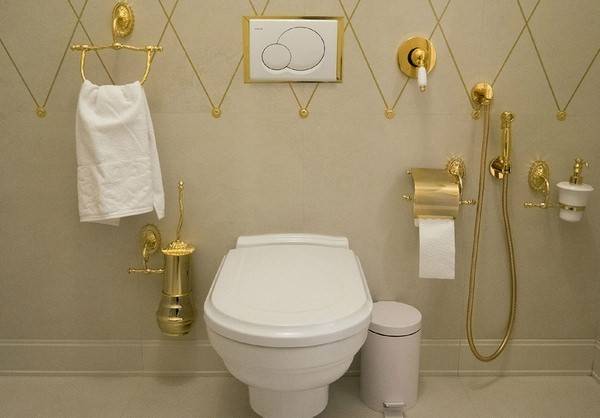
In any case, it is necessary to bring water pipes to the mixer inside or outside the wall and connect them. Often a thermostat is built into such a system, which is also mounted on the wall.
Installing the faucet on the sink
When there is a sink in the bathroom, it is not difficult to conduct a hygienic shower for the toilet from it. First you need to decide on the type of faucet on the sink. If it is already installed, then you may not need to purchase a new device. A prerequisite is the presence of a watering can of a special form, designed for hygiene procedures.
If there is no mixer yet, then buy just such a mixer, as described above. Its installation is not difficult. The flexible hose should freely reach the toilet. Usually it works in conjunction with a spout. When the faucet is open, water flows into the spout, and when the button on the shower is pressed, the water rushes into the flexible hose.
Built-in toilet shower
When a toilet with a hygienic shower (bidet toilet) is installed in the room, the old toilet is first dismantled. In its place, a new device is installed and attached to the floor or wall. In the new room, the toilet is immediately installed in a permanent place.
When the built-in hygienic shower in the toilet is connected, the connection diagram is as follows:
- water hoses are connected to the mixer;
- the mixer is inserted into the existing hole and fastened there;
- the ends of the hoses are wound onto water pipes;
- shower tests and mixer operation are carried out;
- if a retractable nozzle is used, its operation is checked.
Installation of the bidet cover
This work can be easily carried out on your own, since it does not involve violating the integrity of the walls and tie-in to the plumbing system. It is enough to purchase a tee, which will be installed next to the toilet bowl.
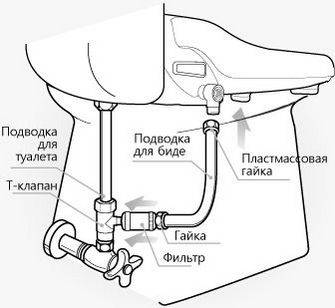
Do-it-yourself installation of this type of hygienic shower in the toilet is carried out in the following sequence:
- the old lid is removed from the toilet, and a bidet lid is attached instead;
- the water in the system is blocked;
- the tank is completely drained;
- the supply hose is unscrewed, through which water flows into the tank;
- a tee is installed between the water pipe and the tank. One end of the tee enters the tank, and the other is connected to the toilet lid;
- if the device is controlled by an electric drive, then it is connected to a socket specially designed for this purpose.
When buying a hygienic toilet shower, try to focus not only on the price, but also on well-known manufacturers that specialize in the production of such accessories. Thus, you will provide yourself with high-quality equipment, the purchase of which you will not regret.
Connecting a hygienic shower to a sink
If there is a sink in the toilet, you can connect a hygienic shower to its mixer. True, in this case, it will be necessary to replace the already installed mixer with a special model equipped with a third outlet of mixed water for a hygienic watering can.
This equipment works according to the following principle:
- when the handle of a single-lever mixer is turned, water rushes into the sink through the spout (spout) and into the hygienic shower hose, in which it is held by a shut-off valve;
- when you press the button on the handle, water starts to flow from the shower head, but at the same time it stops pouring from the faucet spout.
The place and height of the installation of the holder of the hygienic shower head is chosen so that it is convenient for a person to use this plumbing device. The holder can be fixed near the sink or near the toilet. When buying mixing equipment, pay attention to the length of the watering can hose, especially if the sink is at a considerable distance from the toilet. Here is a clear example of how to choose a suitable place to mount the unit:
You can increase the functionality of the equipment installed in the toilet in a couple of hours. After all, you just need to replace the mixer, which is already connected to existing communications. You don’t even have to wait for the start of cosmetic or major repairs in the room.
If there is no sink in the bathroom, then plumbers recommend installing it by choosing a small corner model. In this case, all the necessary hygiene procedures can be carried out without leaving the toilet room. This is true for separate bathrooms.
Installation of a universal bidet attachment on the toilet
Installation of a hygienic shower in a small toilet is carried out directly on the toilet. They call this equipment a compact bidet attachment for universal use, so installation can be carried out on any type of toilet bowl.
The bidet set-top box should include:
- mixer tap for cold and hot water;
- shower hose;
- watering can hygienic;
- special mounting plate.
The bidet attachment can be installed under the toilet cover on the left or right side (depending on the location of the toilet bowl in the bathroom and the availability of free space around the plumbing fixture). After completion of installation work, water is supplied to the mixer using flexible hoses.
Instructions for assembling such a bidet set-top box:
- Install the gasket on the mixer (A) and connect the nozzle (D) to it.
- Attach the faucet to the fixing plate (B) and then fix the parts with a clamp with a gasket (D) and clamping nut (E).
- Next, connect the water hoses to the faucet (K).
- Attach the adapter nut (G) to the nozzle.
- Screw the watering can hose (I) into the adapter nut.
- Connect the watering can itself to the free end of the hose (З).
- Remove the double-sided tape protection from the mounting plate elements.
- Spend installation of a fixing plate on a place of fastening of a cover of a toilet bowl.
- Then proceed to install the toilet lid itself, placing it on top of the mounting plate.
- Attach the toilet lid.
